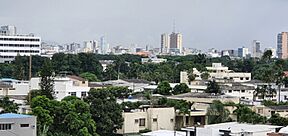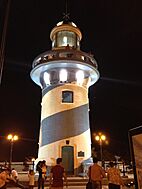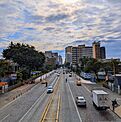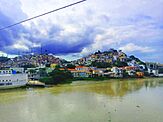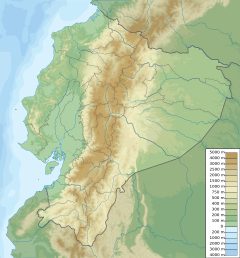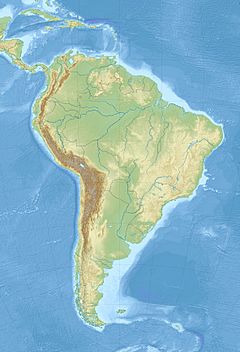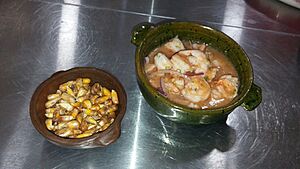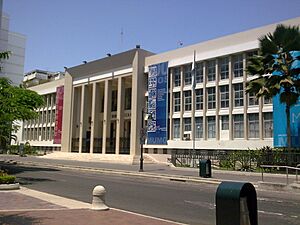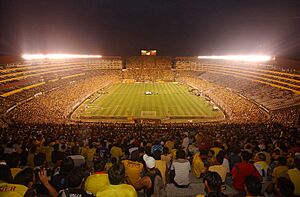Guayaquil facts for kids
Quick facts for kids
Guayaquil
Santiago de Guayaquil
|
|||
|---|---|---|---|
| Santiago of Guayaquil | |||
|
Skyline of Guayaquil
Lighthouse on Santa Ana Hill
Guayaquil Metropolitan Cathedral
Malecón 2000
Ninth of October Avenue (Avenida Nueve de Octubre)
Guayaquil, with the Guayas River in the foreground
|
|||
|
|||
| Nickname(s):
La Perla del Pacífico
English: The Pearl of the Pacific |
|||
| Motto(s):
Por Guayaquil Independiente
English: For Independent Guayaquil |
|||
| Country | |||
| Province | |||
| Canton | Guayaquil | ||
| Spanish foundation | 25 July 1535 | ||
| Independence | 9 October 1820 | ||
| Founded by | Francisco de Orellana | ||
| Named for | Guayas and Quil | ||
| Urban parishes | 16 urban parishes | ||
| Government | |||
| • Type | Mayor and council | ||
| Area | |||
| • City | 344.5 km2 (133.01 sq mi) | ||
| • Land | 316.42 km2 (122.17 sq mi) | ||
| • Water | 28.08 km2 (10.84 sq mi) | ||
| • Metro | 2,493.86 km2 (962.88 sq mi) | ||
| Elevation | 4 m (13.2 ft) | ||
| Population
(2022)
|
|||
| • City | 2,650,288 | ||
| • Density | 7,693.1/km2 (19,925.5/sq mi) | ||
| • Urban | 3,094,420 | ||
| • Metro | 3,193,267 | ||
| Demonym(s) | Guayaquileño | ||
| GDP (PPP, constant 2015 values) | |||
| • Year | 2023 | ||
| • Total | $42.9 billion | ||
| • Per capita | $17,300 | ||
| Time zone | UTC−5 (ECT) | ||
| Postal code |
EC090150
|
||
| Area code(s) | (0)4 | ||
| Vehicle registration | G | ||
| Languages | Spanish | ||
| Climate | Aw | ||
| Website | Municipality of Guayaquil | ||
Guayaquil (Spanish pronunciation: [ɡwaʝaˈkil]; Quechua: Wayakil), officially called Santiago de Guayaquil, is the biggest city in Ecuador. It is also the country's main economic center and most important port. The city is the capital of Guayas Province and the main city of Guayaquil Canton. You can find Guayaquil on the west bank of the Guayas River, which flows into the Pacific Ocean through the Gulf of Guayaquil.
Contents
The Name of Guayaquil
The name Santiago de Guayaquil has a long history. The "Guayaquil" part comes from before the Spanish arrived. "Santiago" was added by the Spanish in 1534. It honors their patron saint, Santiago, who is also the patron saint of Spain.
One popular story, passed down through generations, says the name Guayaquil comes from a local leader named Guayas and his wife Quil. Legend says they fought bravely against the Spanish. They even set their town on fire rather than give up.
Another theory suggests the name comes from a leader named Guayaquile. This leader ruled a town near modern-day Durán. Historians believe the Spanish named the area after him. The chonos people, known as Cultura Milagro-Quevedo, lived in this region.
After moving locations and suffering fires, the city was officially founded in 1547. It was called the "Very Noble and Very Loyal City of Santiago de Guayaquil." After Ecuador gained independence in 1820, the "noble and loyal" part was dropped. Today, the full official name is mostly used for formal events.
Guayaquil's History
Guayaquil was founded on July 25, 1538, by the Spanish explorer Francisco de Orellana. He built it on the site of an old native village.
In 1687, English and French pirates attacked and robbed Guayaquil. Many people were hurt or killed during this raid. In 1709, other English captains also looted the city. They left quickly when a sickness called yellow fever spread.
During colonial times, Guayaquil was a major Spanish shipyard in the Pacific. It was also a key stop for trade ships. These ships traveled between Asia and Latin America, carrying goods from places like the Philippines.
By the late 1700s, many enslaved people lived in Guayaquil. Some worked in homes, like María Chiquinquirá, who famously won her freedom in court in 1794. Others worked in shipyards alongside free workers. Enslaved people increasingly fought for their freedom. They formed a social group called the plebe.
On October 9, 1820, Guayaquil declared its independence from Spain. This happened almost peacefully. A group of citizens and soldiers took control. José Joaquín de Olmedo became the city's leader.
Later, General Antonio José de Sucre led an army from Guayaquil. He was sent by Simón Bolivar. This army won the Battle of Pichincha. This victory secured independence for Gran Colombia and what would become Ecuador.
In 1822, generals José de San Martín and Simón Bolívar met in Guayaquil. They planned how to complete the independence of Peru and all of Spanish South America. In 1829, the Peruvian Army invaded Guayaquil. They occupied the city for seven months.
In 1860, the Battle of Guayaquil took place. This battle was between different Ecuadorian groups. The forces led by Gabriel García Moreno won. This helped Ecuador become stronger and less influenced by Peru.
A large fire destroyed much of the city in 1896.
In 1898, Guayaquil officially recognized its anthem. It was written by José Joaquín de Olmedo in 1821. The music was composed by Ana Villamil Ycaza in 1895. It is now known as the Guayaquil Anthem.
In 1922, workers in the city went on a strike. It lasted three days. Sadly, many people were killed by the military and police.
In 2020, the city was greatly affected by the COVID-19 pandemic.
Guayaquil's Economy
The people of Guayaquil, called Guayaquileños, earn money from many things. These include formal and informal trade, businesses, farming, and raising seafood. Many small and medium businesses operate here. There is also a large informal economy that provides jobs for thousands.
The Port of Guayaquil is Ecuador's most important commercial port. Most goods imported and exported from Ecuador pass through the Gulf of Guayaquil. Since Guayaquil is the largest city, many industries are located here or nearby.
Tourism in Guayaquil
Guayaquil is a lively city and a key part of Ecuador's economy. It is also a growing tourist spot. In recent years, it has become a popular place for business meetings and conventions. Its many tall buildings give it the look of a major city.
Some popular tourist attractions in Guayaquil include:
- Torre Morisca (Moorish Tower)
- Malecon 2000 (a riverside boardwalk)
- Seminario Park, also known as Iguana Park
- Las Peñas neighborhood
- Guayaquil Cathedral
- La Rotonda hemicycle
- Puerto Santa Ana
- MAAC (Museum of Anthropology and Contemporary Art)
- Nahim Isaias Museum
Guayaquil's location makes it a great starting point for trips to the Galapagos Islands. The city has won several World Travel Awards. These include "South America's Leading City Break Destination" and "South America's Leading Meetings and Conferences Destination."
The city offers many activities and events. You can take shopping tours, food tours, or religious tours. There are also tours to farms. The Municipality of Guayaquil offers free tours. You can also find self-guided tours and digital maps to explore the city's attractions.
Geography and Climate
Guayaquil is Ecuador's largest city and the capital of Guayas Province. It sits on the Guayas River, about 40 miles (64 km) north of the Gulf of Guayaquil. The city is very close to the Equator.
Guayaquil faces risks from earthquakes. This is because of its soil and location on the "Ring of Fire." The city's soft soil can make earthquake damage worse. The nearby Gulf of Guayaquil also has many active fault lines. However, tsunami threats are mostly for coastal farming areas, not the main city.
In 2016, a strong 7.8 magnitude earthquake hit Ecuador. Guayaquil was affected. A bridge collapsed, and two people died.
Guayaquil's Climate
Guayaquil has a tropical savanna climate. From January to April, it is hot and humid with heavy rain. This rain can cause flooding, especially during El Niño years. The rest of the year, from May to December, there is very little rain. This is due to the cool influence of the Humboldt Current. Mornings and afternoons are often cloudy, and evenings have cool breezes.
| Climate data for Guayaquil (1981–2010) | |||||||||||||
|---|---|---|---|---|---|---|---|---|---|---|---|---|---|
| Month | Jan | Feb | Mar | Apr | May | Jun | Jul | Aug | Sep | Oct | Nov | Dec | Year |
| Record high °C (°F) | 37.2 (99.0) |
35.4 (95.7) |
37.3 (99.1) |
35.8 (96.4) |
36.3 (97.3) |
35.0 (95.0) |
34.1 (93.4) |
35.0 (95.0) |
34.4 (93.9) |
35.1 (95.2) |
35.4 (95.7) |
36.7 (98.1) |
37.3 (99.1) |
| Mean daily maximum °C (°F) | 31.2 (88.2) |
31.2 (88.2) |
32.2 (90.0) |
32.0 (89.6) |
31.2 (88.2) |
29.8 (85.6) |
29.1 (84.4) |
29.7 (85.5) |
30.5 (86.9) |
30.2 (86.4) |
31.1 (88.0) |
31.8 (89.2) |
30.8 (87.4) |
| Daily mean °C (°F) | 27.1 (80.8) |
27.3 (81.1) |
28.0 (82.4) |
27.8 (82.0) |
26.9 (80.4) |
25.7 (78.3) |
25.0 (77.0) |
25.2 (77.4) |
25.5 (77.9) |
25.6 (78.1) |
26.2 (79.2) |
27.1 (80.8) |
26.5 (79.7) |
| Mean daily minimum °C (°F) | 23.0 (73.4) |
23.4 (74.1) |
23.7 (74.7) |
23.5 (74.3) |
22.6 (72.7) |
21.5 (70.7) |
20.8 (69.4) |
20.7 (69.3) |
20.5 (68.9) |
20.9 (69.6) |
21.3 (70.3) |
22.4 (72.3) |
22.0 (71.6) |
| Record low °C (°F) | 20.0 (68.0) |
15.8 (60.4) |
19.9 (67.8) |
19.4 (66.9) |
18.5 (65.3) |
17.6 (63.7) |
17.0 (62.6) |
17.2 (63.0) |
17.2 (63.0) |
17.8 (64.0) |
17.0 (62.6) |
18.0 (64.4) |
15.8 (60.4) |
| Average precipitation mm (inches) | 200.7 (7.90) |
332.0 (13.07) |
315.7 (12.43) |
207.7 (8.18) |
62.6 (2.46) |
34.0 (1.34) |
15.6 (0.61) |
1.2 (0.05) |
1.5 (0.06) |
5.6 (0.22) |
29.1 (1.15) |
68.0 (2.68) |
1,263.2 (49.73) |
| Average precipitation days (≥ 1.0 mm) | 12 | 14 | 15 | 10 | 4 | 1 | 0 | 0 | 0 | 0 | 1 | 2 | 59 |
| Source 1: World Meteorological Organization | |||||||||||||
| Source 2: NOAA | |||||||||||||
Guayaquil City Areas
Guayaquil is divided into many different areas. These areas help organize the large city. You can find a full list of these neighborhoods and parishes online.
| Guayaquil City Territorial Organization Number of the sector in reference with the City Map |
|||||||
| # | Sectors | # | Sectors | # | Sectors | ||
|---|---|---|---|---|---|---|---|
| 1 | 9 de Octubre Este | 25 | Febres Cordero | 49 | Prosperina | ||
| 2 | 9 de Octubre Oeste | 26 | Floresta | 50 | Puerto Azul Norte | ||
| 3 | Abel Gilbert | 27 | La Florida | 51 | Puerto Azul Sur | ||
| 4 | Acuarela | 28 | García Moreno | 52 | Puerto Lisa | ||
| 5 | Los Álamos | 29 | Garzota | 53 | Quinto Guayas Este | ||
| 6 | Alborada Este | 30 | Guangala | 54 | Quinto Guayas Oeste | ||
| 7 | Alborada Oeste | 31 | Guasmo Este | 55 | Río Guayas | ||
| 8 | Los Almendros | 32 | Guasmo Oeste | 56 | Roca | ||
| 9 | Las Américas | 33 | Huancavilca | 57 | Rocafuerte | ||
| 10 | Atarazana | 34 | Isla Trinitaria | 58 | La Saiba | ||
| 11 | Ayacucho | 35 | Kennedy | 59 | Samanes | ||
| 12 | Bastión Popular | 36 | Letamendi | 60 | San Eduardo | ||
| 13 | Batallón del Suburbio | 37 | Luz del Guayas | 61 | Los Sauces | ||
| 14 | Bellavista | 38 | Mapasingue | 62 | Simón Bolívar | ||
| 15 | Bolívar | 39 | Miraflores | 63 | Sopeña | ||
| 16 | Los Ceibos | 40 | Monte Bello | 64 | Sucre | ||
| 17 | Centenario | 41 | Olmedo | 65 | Tarqui | ||
| 18 | Cerro del Carmen | 42 | Las Orquídeas Este | 66 | Unión | ||
| 19 | Cóndor | 43 | Las Orquídeas Oeste | 67 | Urdenor | ||
| 20 | Cuba | 44 | Paraíso | 68 | Urdaneta | ||
| 21 | Del Astillero | 45 | Pascuales | 69 | Urdesa | ||
| 22 | Estero Salado | 46 | Pedro Carbo | 70 | Los Vergeles | ||
| 23 | Los Esteros | 47 | Las Peñas | 71 | Ximena | ||
| 24 | La FAE | 48 | La Pradera | 72 | Mirador Norte | ||
You can find a list of Neighborhoods and Parishes of Guayaquil online.
Guayaquil's Population
Guayaquil is a very populated city. Its population has grown a lot over the years. The tables below show how the population has changed.
| Historical Populations Guayaquil City Compared with Guayas Province, Canton of Guayaquil, and Guayaquil City |
|||
| Census | Guayas Province | Canton of Guayaquil | Guayaquil City |
| 1950 | 582.144 | 331.942 | 258.966 |
| 1962 | 979.223 | 567.895 | 510.804 |
| 1974 | 1,512,333 | 907.013 | 823.219 |
| 1982 | 2.038.454 | 1.328.005 | 1.199.344 |
| 1990 | 2,515,146 | 1,570,396 | 1,508,444 |
| 2001 | 3,309,034 | 2,039,781 | 1,985,379 |
| 2010 | 3,645,483 | 2,350,915 | 2,291,158 |
| Source: Instituto Nacional de Estadisticas y Censos | |||
| Percentage Population Growth of Guayaquil City Compared with Guayas Province, Canton of Guayaquil, and Guayaquil City. |
|||
| Census | Guayas Province | Canton of Guayaquil | Guayaquil City |
| 1950–1962 | 4.34% | 4.49% | 5.67% |
| 1962–1974 | 3.77% | 4.06% | 4.14% |
| 1974–1982 | 3.52% | 4.50% | 4.44% |
| 1982–1990 | 2.63% | 2.10% | 2.87% |
| 1990–2001 | 2.49% | 2.38% | 2.50% |
| 2001–2010 | 1.12% | 1.69% | 1.71% |
| Source: Instituto Nacional de Estadisticas y Censos | |||
Delicious Food
Guayaquil's food is mostly seafood dishes. Some popular ones include encebollado, ceviche, cazuela, and encocado. Encocado is shrimp or tuna with a coconut sauce and rice.
For breakfast, patacones (fried plantains) and bolon are very common. Bolon is mashed fried plantain mixed with cheese. These plantain dishes often come with steak or encebollado de pescado.
Other breakfast favorites are empanadas. Empanadas de viento are made with wheat flour and stretchy cheese. Empanadas de verde are plantain-based with mozzarella cheese.
Pan de yuca, which is similar to Brazilian cheese bread, is a typical snack. It's usually served with "yogur persa." You can also find many shawarma shops due to Middle Eastern influences.
Chifa dishes are Chinese-Ecuadorian foods. These include arroz chaufa (fried rice), tallarin saltado (stir-fried noodles), and sopa Fui Chi Fu (soup). These are popular fast food choices.
Other unique dishes from Guayaquil include plantain ball soup. This soup has green plantain balls filled with meat. Bollo is another typical dish, similar to a hallaca, made with green plantain and seafood. You might also try biche, sango de mariscos, and arroz con pescado frito (rice with fried fish).
Many other tasty dishes are part of Guayaquil's diverse food scene. These include arroz con menestra y carne asada (rice with stew and roast meat), churrasco, Guatita, and Caldo de mondongo.
Famous People from Guayaquil
Many talented people in arts, literature, and other fields come from Guayaquil.
Arts and Literature
- Daniela Alcívar Bellolio (b. 1982, Guayaquil) - Writer
- Félix Aráuz (b. 1935, Guayaquil) - Artist
- Theo Constanté (1934–2014, Guayaquil) - Artist
- José de la Cuadra (1903, Guayaquil – d. 1941, Guayaquil) - Writer
- Alfredo Pareja Diezcanseco (1908, Guayaquil – d. 1993, Quito) - Writer
- Carmen Febres-Cordero de Ballén (b. 1829, Guayaquil – d. 1893, Valparaíso) - Writer
- Araceli Gilbert (b. 1913, Guayaquil – d. 1993, Quito) - Artist
- Enrique Gil Gilbert (1912, Guayaquil – d. 1973, Guayaquil) - Writer
- Julio Jaramillo (b. 1935, Guayaquil – d. 1978, Guayaquil) - Singer
- Joaquín Gallegos Lara (b. 1909, Guayaquil – d. 1947, Guayaquil) - Writer
- Numa Pompilio Llona (b. 1832, Guayaquil – d. 1907, Guayaquil) - Poet
- Demetrio Aguilera Malta (b. 1909, Guayaquil – d. 1981, Mexico) - Writer
- Luis Miranda (b. 1932, Guayaquil) - Painter
- Luis Molinari (b. 1929, Guayaquil) - Artist
- Elisa Ortiz de Aulestia (b. 1909, Guayaquil – 1991) - Writer
- Xavier Blum Pinto (b. 1957, Guayaquil) - Artist
- José Martínez Queirolo (b. 1931, Guayaquil – d. 2008, Guayaquil) - Playwright
- Víctor Manuel Rendón (b. 1859, Guayaquil – d. 1940, Guayaquil) - Writer
- Enrique Tábara (b. 1930, Guayaquil) - Artist
- Jorge Velarde (b. 1960, Guayaquil) - Artist
- Juan Villafuerte (b. 1945, Guayaquil – d. 1977, Barcelona, Spain) - Painter
- Eugenia Viteri (b. 1928, Guayaquil) - Writer
Other Notable People
- Olga Álava, Miss Earth 2011
- Noralma Vera Arrata, ballerina
- Frederick Ashton, British choreographer
- Geovanni Camacho, football player
- María Elisa Camargo, actress
- Danilo Carrera, actor
- Fernanda Cornejo, Miss International 2011
- Felipe Caicedo, footballer
- María Capovilla, once the oldest person in the world
- Jorge Delgado, swimmer
- Beatriz Parra Durango, opera singer
- Jenny Estrada, writer
- Jorge Perrone Galarza, politician
- Karina Galvez, poet
- Gerardo, rapper
- Andrés Gómez, tennis player
- Catalina de Jesús Herrera, nun and writer
- Mike Judge, American animator
- Guillermo Lasso, former President of Ecuador
- Rita Lecumberri, writer
- Roberto Manrique, actor
- Debbie Mucarsel-Powell, American politician
- Francisco Nazareno, footballer
- Adalberto Ortiz, poet
- María Mercedes Pacheco, actor
- Albert Paulsen, actor
- Joao Plata, footballer
- Jorge Saade, violinist
- Hugo Savinovich, wrestler
- Pancho Segura, tennis player
- María del Tránsito Sorroza, midwife
- Jan Topić, businessman
- Benjamin Urrutia, academic
- Pedro Jorge Vera, writer
- Alex Jimbo Viteri, violinist
- Rosa Borja de Ycaza, writer
- Presley Norton Yoder, archeologist
- Roberta Zambrano, politician
Education in Guayaquil
The Biblioteca Municipal de Guayaquil (Municipal Library of Guayaquil) is the city's public library. Guayaquil has several universities. These include the University of Guayaquil (founded in 1867), the Universidad Catolica de Santiago de Guayaquil, and the Escuela Superior Politecnica del Litoral (ESPOL). Another notable university is the Universidad de Especialidades Espiritu Santo.
Religion
The main religion in Guayaquil is Christianity.
Sports and Recreation
Guayaquil is home to two major association football (soccer) clubs. They are the Barcelona Sporting Club and the Club Sport Emelec. Each club has its own stadium. The Estadio Monumental Banco Pichincha is for the "Barcelonistas." The Estadio George Capwell is for the "Emelecistas." These two teams have a big rivalry. Their games are called "El Clásico del Astillero."
Guayaquil is the birthplace of famous tennis players like Francisco Segura Cano, Andrés Gómez, and Nicolás Lapentti. The "Abierto de Tenis Ciudad de Guayaquil" is a tennis tournament held every November. It is organized by Gómez and Luis Morejon.
Another big event is the Guayaquil Marathon. It has been held every year in early October since 2005. This race is certified by the Association of International Marathons and Distance Races (AIMS).
The Parque Samanes de Guayaquil is a large sports and ecological park. It has courts for soccer, tennis, volleyball, and basketball. There are also two lakes, a soccer stadium, and an amphitheater for concerts. The park connects to a forest reserve with trails for cycling and walking. It also has facilities for climbing and zip-lining.
Universities
Here are some of the main universities in Guayaquil:
- Escuela Superior Politécnica del Litoral
- Universidad de Especialidades Espíritu Santo
- University of Guayaquil
- Universidad Católica de Santiago de Guayaquil
- Universidad Laica Vicente Rocafuerte
- Universidad Casa Grande
- Universidad Tecnológica Ecotec
- Universidad Santa María
- Blue Hill College
- Universidad Del Pacífico – Ecuador
- Institute of Graphics Arts and Digital Science
- Universidad Politécnica Salesiana
Transportation
Guayaquil is located along national Highway 40 and near Highway 25.
The city has a major seaport and an international airport. The seaport is the largest in Ecuador. It handles a lot of shipping traffic on the Pacific coast. The José Joaquín de Olmedo International Airport was rebuilt in 2006. The old terminal is now a convention center.
Guayaquil also has a bus rapid transit system called Metrovia. It opened in 2006. The system has three lines and many feeder routes. It carries about 400,000 passengers every day.
The Empresa de Ferrocarriles Ecuatorianos offers tourist train service. You can take a train to Quito from Durán, a city across the Guayas River.
Port of Guayaquil
The Port of Guayaquil is the most important port in Ecuador. It is also one of the biggest ports in Latin America. The port can handle a lot of cargo. It is also a key place for transferring goods to other countries in the Pacific region. The Guayaquil Port Authority, which is run by the state, manages the port.
Sister Cities
Guayaquil is connected with these cities around the world:
Images for kids
See also
 In Spanish: Guayaquil para niños
In Spanish: Guayaquil para niños


